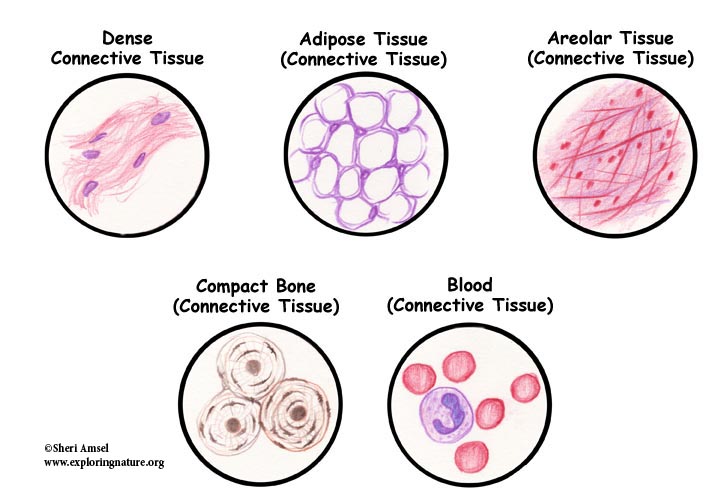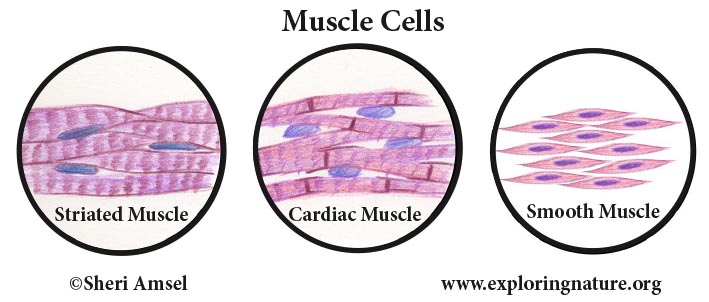

Tissues are groups of cells with a common structure (form) and function (job). There are four main tissues in the body – epithelium, muscle, connective tissue and nervous tissue.
I. EPITHELIUM (EPITHELIAL TISSUE)
Functions (jobs):
Characteristics (Traits):
1) Closely attached to each other forming a protective barrier.
2) Always has one free (apical) surface open to outside the body or inside (cavity) an internal organ.
3) Always had one fixed (basal) section attached to underlying connective tissue.
4) Has no blood vessels but can soak up nutrients from blood vessels in connective tissue underneath.
5) Can have lots of nerves in it (innervated).
6) Very good at regenerating (fixing itself). i.e. sunburn, skinned knee.
Classifications (types):
1) By shape:
a) squamous - flat and scale-like
b) cuboidal - as tall as they are wide
c) columnar - tall, column-shaped
2) By cell arrangement:
a) simple epithelium - single layer of cells (usually for absorption and filtration)
b) stratified epithelium - stacked up cell layers (protection from abrasion - mouth, skin.)
There is also pseudostratified epithelium - looks like stacked cell layers, but is actually a single layer of cells (trachea and upper respiratory tract, it secretes muscous and its cilia helps to propel foreign material out of the body through coughing)
II. CONNECTIVE TISSUE
Functions (jobs):
The 3 Elements of Connective Tissue:
1) Ground substance – gel around cells and fibers
2) Fibers – provide strength, elasticity and support
3) Cells
IIa. SPECIAL CONNECTIVE TISSUES
1) Cartilage
Functions (jobs):
2) Bone
Functions (jobs):
More about Bone Tissue and Bone Structure: LINK
3) Blood
Functions (jobs):
III. NERVOUS TISSUE
Functions (jobs):
Conducts impulses to and from body organs via neurons.
The 3 Elements of Nervous Tissue:
1) Brain
2) Spinal cord
3) Nerves
More about how nervous tissue works: LINK
IV. MUSCLE TISSUE
Functions (jobs):
The 3 Types of Muscle Tissue:
More about how muscular tissue works: LINK
Body Tissues (Histology) Color Mini-Poster: LINK
When you research information you must cite the reference. Citing for websites is different from citing from books, magazines and periodicals. The style of citing shown here is from the MLA Style Citations (Modern Language Association).
When citing a WEBSITE the general format is as follows.
Author Last Name, First Name(s). "Title: Subtitle of Part of Web Page, if appropriate." Title: Subtitle: Section of Page if appropriate. Sponsoring/Publishing Agency, If Given. Additional significant descriptive information. Date of Electronic Publication or other Date, such as Last Updated. Day Month Year of access < URL >.
Amsel, Sheri. "Tissues - Epithelium, Muscle, Connective Tissue and Nervous Tissue (Histology)" Exploring Nature Educational Resource ©2005-2024. December 13, 2024
< http://www.exploringnature.org/db/view/Tissues-Epithelium-Muscle-Connective-Tissue-and-Nervous-Tissue >




